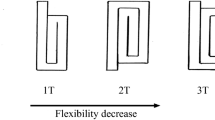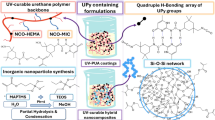Abstract
In this study, a dendrimer with 19 sites was modified to form a waterborne oligomer with hydrophilic sites and polyurethane acrylate (PUA) sites. Two PU systems hexamethylene diisocyanate (HDI) and methylene-bis (4-cyclohexylisocyanate) (HMDI) were used; each of them had 5, 9, and 13 PUA sites, respectively. Experimental results revealed that the HDI system was more thermally stable than the HMDI system. The HMDI system, however, exhibited better hardness than the HDI system, even though the final curing conversion of HMDI was low. Additionally, more PUA sites of a dendrimer were associated with greater hardness of the cured resin. In a UV-curing study, simulations revealed that the autocatalysis model could describe the UV-curing mechanism of the PUA-dendrimer system. Both the reaction rate constant k and the final conversion α were highest at a concentration of the photoinitiator of approximately 3 wt% for both HDI and HMDI systems. The reaction rates of both systems were highest when the number of PUA sites was nine. The final conversion of both the systems, however, was optimal when the number of PUA sites was 13. The final conversion in the acrylic reaction increased with temperature up to 80 °C for both the systems, owing to an increase in the ratio of potentially active sites against nonactive sites, according to Arrhenius theory. The rate constant, k, however, was optimal at 60 °C because a higher temperature damaged the photoinitiator. Finally and most importantly, HMDI always had a lower rate constant k and final conversion α than HDI under similar conditions in studies that were conducted to examine the effects of photoinitiator concentration, number of PUA sites, and reaction temperature, revealing that the steric hindrance by the cyclohexane in HMDI negatively influenced its curing kinetics.











Similar content being viewed by others
References
Tey JN, Soutar AM, Priyadarshi A, Mhaisalkar SG, Hew KM (2007) Ink and moisture sorption study in UV-curable polyurethane acrylate. J Appl Polym Sci 103:1985–1991
Ha C, Jung S, Kim E, Kim W, Lee S, Cho J (1996) Properties of UV-curable polyurethane acrylates using nonyellowing polyisocyanate for floor coating. J Appl Polym Sci 62:1011–1021
Kim BK, Lee KH, Kim HD (1996) Preparation and properties of UV-curable polyurethane acrylate. J Appl Polym Sci 60:799–805
Athawale VD, Kulkarni MA (2009) Preparation and properties of urethane/acrylate composite by emulsion polymerization technique. Prog Org Coat 65:392–400
Ortiz RA, Flores RVG, Garcia AE, Valdez ML, Duarte B (2010) Novel second generation dendrimer with terminal thiol groups prepared via click chemistry and its thiol-ene photopolymerization with unsaturated monomers. Prog Org Coat 69:463–469
Schwalm R (2006) UV coatings basics recent developments and new applications. Elsevier, Amsterdam
Tomalia DA (1995) Dendrimer molecules. Sci Am 272:62–66
Frechet JM (1994) Functional polymers and dendrimers: reactivity, molecular architecture, and interfacial energy. J Sci 263:1710–1715
Zhang Y, Asif A, Shi W (2011) Highly branched polyurethane acrylates and their waterborne UV curing coating. Prog Org Coat 71:295–301
Zeng F, Zimmerman SC (1997) Dendrimers in supramolecular chemistry: from molecular recognition to self-assembly. Chem Rev 97:1681–1712
Adronov A, Fréchet JMJ (2000) Light-harvesting dendrimers. Chem Commun 1701–1710
Momotake A, Arai T (2004) Photochemistry and photophysics of stilbene dendrimers and related compounds. J Photochem Photobiol C 5:1–25
Chen X, Yuan H, Song L, Jiao C (2008) Preparation and thermal properties of a novel UV-cured star polyurethane acrylate coating. Polym Adv Technol 19:322–327
Bongiovanni R, Montefusco F, Priola A, Macchioni N, Lazzeri S, Sozzi L, Ameduri B (2002) High performance UV-cured coatings for wood protection. Prog Org Coat 45:359–363
Kim HD, Kang SG, Ha CS (1992) Properties of UV-curable polyurethane acrylates for primary optical fiber coating. J Appl Polym Sci 46:1339–1351
Lange J, Stenroos E, Johansson M, Malmström E (2001) Barrier coatings for flexible packaging based on hyperbranched resins. Polymer 42:7403–7410
Zhu S-W, Shi W-F (2002) Synthesis and photopolymerization of hyperbranched polyurethane acrylates applied to UV curable flame retardant coatings. Polym Int 51:223–227
Menjoge AR, Kannan RM, Tomalia DA (2010) Dendrimer-based drug and imaging conjugates: design considerations for nanomedical applications. Drug Discov Today 15:171–185
Astruc D, Boisselier E, Ornelas C (2010) Dendrimers designed for functions: from physical, photophysical, and supramolecular properties to applications in sensing, catalysis, molecular electronics, photonics, and nanomedicine. Chem Rev 110:1857–1959
Rosen BM, Wilson CJ, Wilson DA, Peterca M, Imam MR, Percec V (2009) Dendron-mediated self-assembly, disassembly, and self-organization of complex systems. Chem Rev 109:6275–6540
Adler H-J, Jahny K, Vogt-Birnbrich B (2001) Polyurethane macromers—new building blocks for acrylic hybrid emulsions with outstanding performance. Prog Org Coat 4:251–257
Yang C-H, Liu F-J, Liu Y-P, Liao W-T (2006) Hybrids of colloidal silica and waterborne polyurethane. J Colloid Interface Sci 302:123–132
Cook WD (1992) Thermal aspects of the kinetics of dimethacrylate photopolymerization. Polymer 33:2152–2161
Young JS, Bowman CN (1999) Effect of polymerization temperature and cross-linker concentration on reaction diffusion controlled termination. Macromolecules 32:6073–6081
Cook WD (1993) Photopolymerization kinetics of oligo(ethylene oxide) and oligo(methylene) oxide dimethacrylates. J Polym Sci A 31:1053–1067
Lecamp L, Youssef B, Bunel C, Lebaudy P (1999) Photoinitiated polymerization of a dimethacrylate oligomer: 2. Kinetic studies. Polymer 40:1403–1409
Nelson EW, Jacobs JL, Scranton AB, Anseth KS, Bowman CN (1995) Photo-differential scanning calorimetry studies of cationic polymerizations of divinyl ethers. Polymer 36:4651–4656
Iojoiu C, Abadie MJM, Harabagiu V, Pinteala M, Simionescu BC (2000) Synthesis and photocrosslinking of benzyl acrylate substituted polydimethylsiloxanes. Eur Polym J 36:2115–2123
Avci D, Nobles J, Mathias LJ (2003) Synthesis and photopolymerization kinetics of new flexible diacrylate and dimethacrylate crosslinkers based on C18 diacid. Polymer 44:963–968
Sourour S, Kamal MR (1976) Differential scanning calorimetry of epoxy cure: isothermal cure kinetics. Thermochim Acta 14:41–59
Kamal MR, Sourour S (1973) Kinetics and thermal characterization of thermoset cure. Polym Eng Sci 13:59–64
Kamal MusaR (1974) Thermoset characterization for moldability analysis. Polym Eng Sci 14:231–239
Bai CY, Zhang XY, Dai JB, Li WH (2006) A new UV curable waterborne polyurethane: effect of C=C content on the film properties. Prog Org Coat 55:291–295
Acknowledgments
The authors would like to thank the National Science Council of the Republic of China, Taiwan, for financially supporting this research under Contract No. NSC.
Author information
Authors and Affiliations
Corresponding author
Rights and permissions
About this article
Cite this article
Rwei, SP., Chen, JD. & Su, CM. Kinetics of UV-curing of waterborne polyurethane acrylate dendrimer. Polym. Bull. 70, 1019–1035 (2013). https://doi.org/10.1007/s00289-012-0868-x
Received:
Accepted:
Published:
Issue Date:
DOI: https://doi.org/10.1007/s00289-012-0868-x




